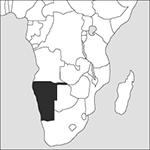
Source: MAPS IN MINUTES™ © RH Publications (1997)
Capital:
Windhoek
Area:
824,292 sq km (317,818 sq miles)
Population:
2,182,852 (2013 est)
Currency:
1 Namibian dollar = 100 cents
Religions:
Christian: between 80.0% and 90.0%; traditional beliefs: between 10.0% and 20.%
Ethnic Groups:
Ovambo 50.0%; Kavango 9.0%; Herero 7.0%; Damara 7.0%; mixed 6.5%; White 6.0%; Nama 5.0%
Languages:
English (official); Afrikaans; German; local languages
International Organizations:
Commonwealth; UN; AU; SADC; Non-Aligned Movement; WTO
A country in southern Africa with borders on Angola in the north, Botswana in the east, and South Africa in the south.
Physical
In the north-east of Namibia a long sliver of territory, the Caprivi Strip, reaches between Angola and Botswana to Zambia. In the west the Namib Desert stretches down the Atlantic Ocean coast; in the east is the Kalahari. The higher land between is also hot and arid and has no permanent rivers.
Economy
Mineral exports provide over half of foreign-exchange earnings. These are dominated by uranium and diamonds, followed by zinc, gold, copper, and lead. Tungsten, silver, and tin are also mined, and reserves of natural gas have recently been discovered. Poor rainfall largely limits agriculture to livestock raising, although some crops are grown; cattle and processed fish are exported. There is a very unequal wealth distribution, with over half the population living in poverty.
History
Namibia was occupied by Khoikhoin (Hottentot), San (Bushman), and Herero peoples when Portuguese navigators explored the coastal areas of the country in the late 15th century. German missionaries went there in the 19th century and in 1884 the German protectorate of South-West Africa was established. In 1915, during World War I, it was captured by South African forces, and in 1920 became a League of Nations mandated territory under South Africa. In 1946 the United Nations refused to allow it to be incorporated into South Africa and ended the mandate (1964), renaming the territory Namibia. In 1971 the International Court of Justice at The Hague ruled that the continued occupation of Namibia by South Africa was illegal and the UN recognized the Black nationalist group, SWAPO (South West Africa People’s Organization), as the legitimate representative of the people of Namibia. A National Assembly for internal government was established by South Africa in 1979 but SWAPO guerrillas continued to operate from Angola, which South African troops invaded. In 1988 South Africa was persuaded by the UN to negotiate with the SWAPO leader Samuel Nujoma. A Geneva protocol was signed in August and SWAPO won elections in November 1989, with Nujoma becoming President. Namibia gained independence as a multiparty democracy in 1990. Walvis Bay, a major port, remained an enclave of South Africa until 1994, when it was returned to Namibia. Nujoma was succeeded as President in 2004 by Hifekepunye Pohamba, who was re-elected in 2009. Pohamba stood down in March 2015 after two terms, as required by the constitution. His Prime Minister, Hage Geingob, was overwhelmingly elected President, and SWAPO also maintained its parliamentary majority. Namibia announced its withdrawal from the International Criminal Court in 2015.
- cyclic vector
- cyclic voltammetry
- cyclin
- cycling
- cycling pool
- cyclization
- cyclo-
- cycloaddition
- cycloalkanes
- cyclobutadiene
- cyclogenesis
- cyclohexadiene-1,4-dione
- cyclohexane
- cycloid
- cyclolysis
- cyclomatic number
- cyclomorphosis
- cyclone
- Cyclone Global Navigation Satellite System
- cyclone separator
- cyclone wave
- cyclonite
- cyclo-octatetraene
- cyclo-oxygenase
- cyclopean concrete